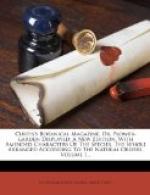The present plant is a native of Peru, and is said by Linnaeus to have been first brought into Europe in the year 1684; it is certainly one of the greatest ornaments the Flower-Garden can boast: it varies in colour, and is also found in the Nurseries with double flowers. The former, as is well known, is propagated by seed; the latter by cuttings, which should be struck on a hot-bed. To have these plants early, they should be raised with other tender annuals; they usually begin to flower in July, and continue blossoming till the approach of winter: the stalks require to be supported, for if left to themselves they trail on the ground, overspread, and destroy the neighbouring plants.
Elizabeth Christina, one of the daughters of Linnaeus, is said to have perceived the flowers to emit spontaneously, at certain intervals, sparks like those of electricity, visible only in the dusk of the evening, and which ceased when total darkness came on.
The flowers have the taste of water-cress, with a degree of sweetness, which that plant does not possess, more particularly resident in the spur of the calyx or nectary; hence are sometimes used in sallads, and hence the plant acquires its name of Nasturtium.
[24]
Agrostemma coronaria. Rose Cockle, or Campion.
Class and Order.
Decandria Pentagynia.
Generic Character.
Calyx 1-phyllus, coriaceus. Petala 5 unguiculata: limbo obtuso, indiviso. Caps. 1-locularis.
Specific Character and Synonyms.
AGROSTEMMA coronaria tomentosa, foliis ovato-lanceolatis, petalis emarginatis coronatis serratis. Lin. Syst. Vegetab. ed. 14. Murr. p. 435. Sp. Pl. p.
LYCHNIS coronaria dioscoridis sativa. Bauh.
Pin. 203. The single red
Rose Campion. Parkins. Parad. p. 252.
[Illustration: No. 24]
Grows spontaneously in Italy and Siberia; Linnaeus informs us that the blossom is naturally white, with red in the middle.
“The single Rose Campion has been long an inhabitant of the English gardens, where, by its seeds having scattered, it is become a kind of weed. There are three varieties of this plant, one with deep red, another with flesh-coloured, and a third with white flowers, but these are of small esteem, for the double Rose Campion being a finer flower, has turned the others out of most fine gardens. The single sorts propagate fast enough by the seeds, the sort with double flowers never produces any, so is only propagated by parting of the roots; the best time for this is in autumn, after their flowers are past; in doing of this, every head which can be slipped off with roots should be parted; these should be planted in a border of fresh undunged earth, at the distance of six inches, observing to water them gently until they have taken root, after which they will require no more, for much wet is injurious to them, as is also dung. After the heads are well rooted, they should be planted into the borders of the Flower-Garden, where they will be very ornamental during the times of their flowering, which is in July and August.” Miller’s Gard. Dict. ed. 6. 4_to._




